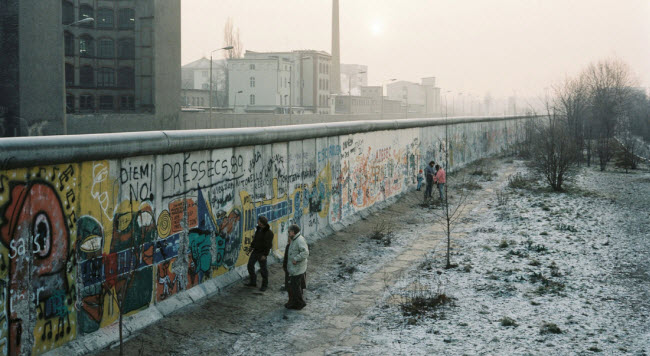Despite the Cold War’s widespread presence around the world, the Berlin Wall, which divided the German capital into two parts, stands as one of its most powerful and enduring symbols. Constructed by the communist government of East Germany in the early 1960s using reinforced concrete, barbed wire, and checkpoints, it aimed to prevent Western fascists from entering and undermining their socialist state, according to their claims. In reality, its primary purpose was to stop mass defections from East to West. The wall stood for nearly 28 years until the East German Communist Party leader announced that citizens could cross the border at will. That night, jubilant crowds surged the wall, crossing into West Berlin, while others brought hammers and chisels to dismantle the wall itself. This event marked the beginning of German reunification and the countdown to the collapse of the Soviet Union.
The Division of Berlin
At the end of World War II in 1945, the Allied peace conferences in Yalta and Potsdam determined the fate of German territories, dividing the defeated nation into four sectors. The eastern part went to the Soviet Union (now Russia), establishing East Germany, officially known as the German Democratic Republic, while the western part was assigned to the United States, the United Kingdom, and France, forming West Germany, officially called the Federal Republic of Germany. Although Berlin, the capital, was entirely within the Soviet-occupied zone, more than 160 kilometers from the eastern and western occupation zones, the Yalta and Potsdam agreements divided the city into similar sectors, with the Soviets controlling the eastern half and the other Allies controlling the western half, starting in June 1945.

The Blockade and Crisis
The presence of capitalist West Berlin deep within communist East Germany was a thorn in the Soviet side, as described by leader Nikita Khrushchev. Therefore, in 1948, the Soviets imposed a blockade on West Berlin, aiming to starve its residents and the Western Allies out of the city. Contrary to Soviet expectations, the United States and its allies responded by airlifting supplies into their sectors of the city, a mission known as the Berlin Airlift, which lasted over a year and delivered more than 2.3 million tons of food, fuel, and other goods to West Berlin. When the Soviets realized the blockade’s failure, they lifted it in 1949.

After a decade of relative calm, tensions flared again in 1958. Over the following years, the Soviets were embarrassed by the steady flow of refugees fleeing from the more affluent and less repressive West Germany. By June 1961, approximately 19,000 East Germans had left through Berlin, with 30,000 fleeing the following month, and 16,000 escaping in the first 11 days of August. On August 12, around 2,400 left in a single day, the largest number of defectors ever recorded.

In response, Soviet Premier Khrushchev authorized the East German government to halt the exodus by closing the border permanently. Within two weeks, the East German army, police, and volunteer builders had erected a temporary barbed-wire fence and concrete wall, known as the Berlin Wall, dividing the city. Prior to the wall, Berliners could move relatively freely between East and West, crossing borders for work, shopping, and entertainment. However, the new wall, reaching four meters in height and stretching 155 kilometers, created a physical barrier that severed neighborhoods and families overnight. Crossing from East to West Berlin became possible only through three checkpoints: Helmstedt (Checkpoint Alpha), Dreilinden (Checkpoint Bravo), and central Berlin (Checkpoint Charlie). Eventually, East Germany established 12 checkpoints along the wall, complete with watchtowers. East German soldiers examined diplomats and other officials before allowing them to enter or leave, and travelers between East and West Berlin were rarely permitted to cross the border.

The Berlin Wall from 1961 to 1989
The Berlin Wall effectively stopped the flow of refugees from East to West and defused the Berlin Crisis. Although President John F. Kennedy was not pleased, he acknowledged that the wall was a better option than war. Nearly two years after its construction, Kennedy visited the wall and gave a famous speech before a crowd of over 120,000 near the Brandenburg Gate, declaring, “Ich bin ein Berliner.”
Overall, from the wall’s construction to its demolition, at least 171 people were killed while attempting to cross it. Despite its stringent security, over 5,000 East Germans (including around 600 border guards) managed to breach the wall through various means, such as jumping from adjacent windows, climbing, cutting through barbed wire, using hot air balloons, crawling through sewers, or driving through less fortified areas at high speeds.
The Fall of the Berlin Wall

In 1989, due to political changes in Eastern Europe and civil unrest, the East German government was pressured to ease some of its travel restrictions to West Germany. On November 9, the spokesperson for the East German Communist Party, Günter Schabowski, announced a change in relations with the West, stating that from midnight that day, citizens of the German Democratic Republic would have the right to cross the border. He did not clarify that some regulations would remain in place. Consequently, East and West Berliners flocked to the wall, celebrating with beer and champagne, chanting “Open the gate!” By midnight, they surged through the barriers along the wall.
By the end of the week, over two million people from East Berlin had visited West Berlin. A journalist described it as “the greatest street party in the history of the world.” People began using hammers and chisels to demolish parts of the wall, earning the nickname “wall bangers.” Soon, cranes and bulldozers were employed to dismantle the wall section by section until it disappeared. Berlin was reunited for the first time since 1945, and a Berliner spray-painted a piece of the wall with “Today, the war has truly ended.” Germany was officially reunified on October 3, 1990, nearly a year after the fall of the Berlin Wall.
